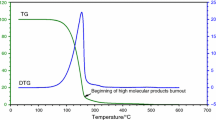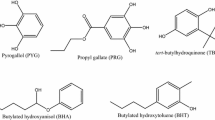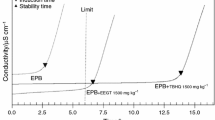Abstract
Even not being described in the EN 14112 standard, PDSC has been used for the determination of the biodiesel oxidative stability, by OIT and OT measurements. In this study, biodiesel blends were obtained by mixing soybean (BES) and castor (BEM) ethyl esters and its induction periods were measured by Rancimat and PDSC. The blends (BSM X ) showed intermediate values of OSI, OT, and OIT, compared with BES and BEM. Although, the molar fraction of the components varied linearly in BSM X , OSI, OT, and OIT values increased exponentially in relation to the castor biodiesel amount in the blends. Introduction of castor oil biodiesel increased the blend stability, so the BSM30 blend reached the OSI limit of 6 h. OSI, OIT, and OT showed a high-linear correlation, pointing out that PDSC can be used in the analysis of this kind of biodiesel, with a smaller sample and analysis time, as compared to Rancimat. The use of biodiesel blends was a good alternative in the correction of the oxidative stability of the final product without the need of antioxidant addition.



Similar content being viewed by others
References
Singh SP, Singh D. Biodiesel production through the use of different sources and characterization of oils and their esters as the substitute of diesel: a review. Renew Sust Energ. 2010;14:200–16.
Candeia RA, Silva MCD, Carvalho Filho JR, Brasilino MGA, Bicudo TC, Santos IMG, Souza AG. Influence of soybean biodiesel content on basic properties of biodiesel-diesel blends. Fuel. 2009;88:738–43.
Conceição MM, Dantas MB, Rosenhaim R, Fernandes VJ Jr, Santos IMG, Souza AG. Evaluation of the oxidative induction time of the ethilic castor biodiesel. J Therm Anal Calorim. 2009;97:643–6.
Park JY, Kim DK, Lee JP, Park SC, Kim YJ, Lee JS. Blending effects of biodiesels on oxidation stability and low temperature flow properties. Bioresource Technol. 2008;99:1196–203.
Vasconcelos AFF, Dantas MB, Filho MGR, Rosenhaim R, Cavalcanti EHS, Antoniosi Filho NR, Sinfrônio FSM, Santos IMG, Souza AG. Influence of drying processes on oxidative stability of ethyl corn biodiesel by differential scanning calorimetry. J Therm Anal Calorim. 2009;97(2):657–60.
Castelló ML, Dweck J, Aranda DAG. Thermal stability and water content determination of glycerol by thermogravimetry. J Therm Anal Calorim. 2009;97(2):627–30.
Knothe G, Dunn RO. Dependence of oil stability index of fatty compounds on their structure and concentration in the presence of metals. J Am Oil Chem Soc. 2003;80:1021–5.
EN 14214 Method. European committee for standardization. Automotive fuels fatty acid methyl esters (FAME) for diesel engines requirements and test methods. European committee for standardization press, Brussels, Belgium; 2003.
AOCS Method Cd 12b-92.3. In: Firestone D, editor. Official methods and recommended practices of the American oil chemists’ society. 5th ed. Champaign: AOCS Press; 1999.
Litwinienko G. Autoxidation of unsaturated fatty acids and their esters. J Therm Anal Calorim. 2001;65:639–46.
Moser BR. Comparative Oxidative Stability of Fatty Acid Alkyl Esters by Accelerated Methods. J Am Oil Chem Soc. 2009;86:699–706.
Candeia RA, Freitas JCO, Souza MAF, Conceição MM, Santos IMG, Soledade LEB, et al. Thermal and rheological behavior of diesel and methanol biodiesel blends. J Therm Anal Calorim. 2007;87:653–6.
Dantas MB, Conceição MM, Fernandes VJ Jr, Santos NA, Rosenhaim R, Marques ALB, et al. Thermal and kinetic study of corn biodiesel obtained by the methanol and ethanol routes. J Therm Anal Calorim. 2007;87:835–9.
Conceição MM, Fernandes VJ Jr, Bezerra AF, Silva MCD, Santos IMG, Silva FC, et al. Dynamic kinetic calculation of castor oil biodiesel. J Therm Anal Calorim. 2007;87:865–9.
Kodali DR. Oxidative stability measurement of high-stability oils by pressure differential scanning calorimeter (PDSC). J Agr Food Chem. 2005;53:7649–53.
Demirbas A. Progress and recent trends in biodiesel fuels. Energ Convers Manage. 2009;50:14–34.
Knothe G. Structure indices in FA chemistry. How relevant is the iodine value? J Am Oil Chem Soc. 2002;79:847–54.
Dunn RO. Oxidative stability of soybean oil fatty acid methyl esters by oil stability index (OSI). J Am Oil Chem Soc. 2005;82:381–7.
Acknowledgements
The authors acknowledge the following Brazilian Agencies for the financial support of this study: Research and Projects Financing (FINEP/MCT) and National Council for Technological Development (CNPq/MCT).
Author information
Authors and Affiliations
Corresponding author
Rights and permissions
About this article
Cite this article
Dantas, M.B., Albuquerque, A.R., Soledade, L.E.B. et al. Biodiesel from soybean oil, castor oil and their blends. J Therm Anal Calorim 106, 607–611 (2011). https://doi.org/10.1007/s10973-011-1410-3
Published:
Issue Date:
DOI: https://doi.org/10.1007/s10973-011-1410-3




